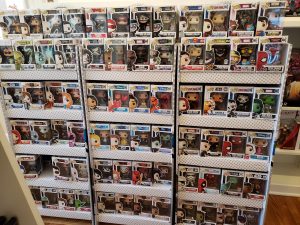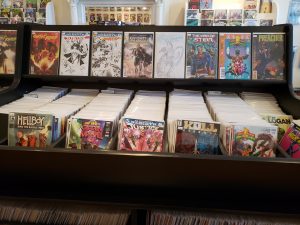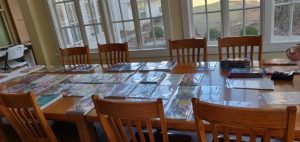Allow me to convince you that Comics Metropolis is the middle-aged man’s time capsule in the same way a vintage arcade is the old-aged man’s time capsule. The entire layout and feel of the store is pitched toward its most frequent customer, a father in his late 30s-mid 4os. To properly analyze the space, I put myself into the shoes of the typical customer walking into the shop; a middle-aged male, middle-class male. For simplicity’s sake in following this this tale, I am naming this frequent customer, Anakin. Upon walking into Comics Metropolis, he is greeted by a corridor panning from the entrance to the furthest part of the store. A discount comic display rests in the center of the hall about one quarter of the way down, blocking him from continuing down that path. Thus, the options are to go left, which you can see more of, or cross right, into the mostly hidden comics room. Anakin turns left and the story begins. So the real question is…what’s the story behind the layout of the shop? To get a better look at the layout of the store, the floor plan is as follows:
Strolling down the more eye-catching path, to the left, Anakin immediately sees fan-favorite paraphernalia such as the iconic Millennium Falcon, Bat-mobile, Justice League figurines, and Star Trek character bobble heads. All of these items come from the same rising era, the era that the middle-aged man walking through the shop grew up in, the late 1970s though the 1980s. The walls are lined with merchandise from these movies, and similar action/science fiction pop culture. As he continues walking into the next room in the back of the store, the merchandise shifts from action and science fiction to fantasy and children’s products. There are loads and loads of board games, paints for costuming, and children’s books/toys. It seems to be a time capsule for the “Star Wars” generation for lack of better words. The middle-aged man who likely has children, walking into the shop visits his own childhood whilst on his way to his child’s current childhood. In this case Anakin has a son, Luke. Once hitting this back room, the round, staring eyes of Peppa Pig on the center display definitely marked the presence of a new generation. This room is for Luke, as Anakin cannot relate to it. To label the rooms, I’d say the first room on the left is Anakin’s room and the last room on the left is Luke’s room.

To get to the “main area” of the comic shop, where the comics are actually kept, the customers have to walk back through from Luke’s room to Anakin’s room to blank corridor to the largest new room, the comic area. I call this area the Collector’s room. This room is lined with comics displayed and in drawers. In order to access any specific comic not on display, the customer must ask for employee assistance. The most notable item in the room in my opinion is the large check-out/cash register area. As comics are their main source of expertise, and the owner’s (Albert’s) passion, it makes sense to me that in order to buy anything, even just an unrelated Peppa Pig memory game for young Luke, every customer must make their way into the comic room for purchases.

Right above the cash register are large, plastic cases with Comics Metropolis’ finest, highest quality comics on display for everyone to see. The check-out desk with the cash register on top is actually glass, so when you Anakin puts his items down on the counter to pay he can’t help but notice the $600 first edition Spider-Man comic with the first appearance of Electro. This room is by far, the most proud and flamboyant room because it’s the only room with plaques on the walls. The focus isn’t just on the floor, it spans the entire length, width, and height. After Anakin purchases said Peppa Pig memory game, if Luke wants to play with his newly purchased item, the pair must make their way from the register through all of the comic aisles to what I call the Playroom, where anyone can sit down for as long as they wish to enjoy their new items. This game room even sports a new vending machine and an outdoor patio section. The Playroom is the most fun room in the house, as evident by its name. In every room there is a connection to an era of a lifetime.
This entire shop stresses the word “family”. It’s a perfect representation of the joint owners, parent and child; mother and son; Laura and Albert. Even more connected to family is “home”, which the shop not only looks like a house, but IS a house because Laura lives upstairs on the second floor. When Anakin and Luke walk into the store, they’re not JUST walking into the store. They’re being welcomed into someone’s home; their place; their personal space. This is a personal bookstore in more ways than one.

To elaborate further on space and place, we can refer back to Cresswell’s Defining Place. “What begins as an undifferentiated space becomes place as we get to know it better and endow it with value…the ideals ‘space’ and ‘place’ require each other for definition.” From the security and stability of place we are aware of the openness, freedom, and threat of space, and vise versa” (Cresswell, 8). The space is the physical shop (i.e. the floor plan), but the place is a journey through different time capsules separated though each room: Anakin’s room, Luke’s room, the Collector’s room, and the Playroom. Personal bookstores have these kinds of places attached. Roger in Parnassus on Wheels explains that his store is a home. Thus every experience held within his selling of books is linked to the place he calls home. His personal life/space and his sales are not mutually exclusive. The owners, Laura and Albert, and the consumers, Anakin and Luke, both impact each other to a further extent than a simple purchase.
Texts:
Cresswell, Tim. Place: a Short Introduction. Blackwell Pub., 2009
Morley, Christopher. Parnassus on Wheels. New York, NY: Grosset & Dunlap Publishers, 1917.
Images:
Floor Plan image courtesy of Kaitlynn Yeager.
ThingLink courtesy of Jessica Arrigo.
Comics Metropolis photos courtesy of Christopher Neiman.

0 Comments